Before you start …
Verify your local laws!
This article is not intended to promote pirating Copyrighted Materials!
Laws, when it comes to copying Copyrighted materials, differ from country to country. It is your responsibility to be aware of these laws and comply to them. See also our Disclaimer!
The movie industry in general does not want you to copy a DVD for any reason. Fair use proponents however claim that the law leaves room for making a private backup (in the US: DMCA or Digital Millenium Copyright Act). But it’s all a matter of interpretation – so think for yourself before you act!
Other countries, like The Netherlands, are more liberal when it comes to this – Consumers pay a few cents extra for empty media, and for personal use you are allowed to make a copy (see Stichting Thuiskopie).
Why DVD to MP4 or MKV?
So you might wonder what MP4 (or M4V) and MKV stand for?
Both are file types; in this case they are so called containers that can contain multiple parts which can be video, audio, subtitles, etc. These particular file types can hold multiple video, audio, and subtitle parts or so called streams.
For example videos in different angles, audio in different languages and qualities (Dolby Surround, Dolby AC3, regular stereo, etc), or subtitles in different languages or types (Closed Caption versus regular subtitles).
The purpose of the files we are about to make will be mainly playback on your computer or other device capable of playback of these kind of files. For example: XBMC box, Tablet PC, iPod/iPad, smartphone, media player in your car, or other media playback capable device.
Here MP4 is the most commonly used format (together with AVI).
MKV on the other hand, although seemingly superior, is not (yet) as popular, but HandBrake supports MKV as well.
MP4 vs M4V
For certain Apple devices, when a AC3 Dolby Surround track and/or Chapters are added, the file extension of an MP4 will become M4V. An M4V file is almost the same as a MP4 file, but it seems that an AC3 audio track and chapters are not considered “valid” in an MP4 file, but perfectly valid in an M4V.
XBMC, VLC and the likes care less if it’s called MP4 or M4V.
Transcoding Other Video sources …
HandBrake also accepts other video sources than just a DVD – including other video files!
It can convert most common video files to MP4 or MKV with ease.
Note : Copying a DVD is commonly referred to as “ripping” a DVD.
For the impatient: the short version …
For those that are impatient and more experienced, you can follow the following steps quickly.
For beginners I recommend to continue reading the following paragraphs which explain a little bit more about what’s happening.
- Install HandBrake.
- Install libdvdcss (see below).
- Start HandBrake.
- Insert DVD.
- Open the “Source” in HandBrake (the DVD).
- Select “Title“.
- Click preferred “Preset” – possibly fine tune settings
- Click “Start“.
- Drink a cup of coffee and eat a cookie – a.k.a. wait and pretend to be patient.
- Done.
Tools we need to Rip a DVD
When using HandBrake, we have all we need in one application, for proper working though we need libdvdcss (to decrypt a DVD).
Downloads
As usual, we offer the needed files for download but we highly recommend that you visit the listed sites below to make sure you get the latest version:
- HandBrake – install by double clicking the downloaded file and follow the instructions.
- libdvdcss – install unzipping the file, renaming “libdvdcss-2.dll” to “libdvdcss.dll” and dragging it into the program folder of HandBrake (for example: C:\Program Files\HandBrake).
Note : libdvdcss versions can be found here, but it can be that newer versions do not have a compiled version for Windows available yet. Check the folders with the highest version numbers and work your way down until you find a version that has a “win32” (32 bit Windows) or “win64” (64 bit Windows) subfolder with the “libdvdcss-2.dll” file in it – this would be the file needed to install libdvdcss. At the time of writing this article, this is the most recent version.
32 Bit Windows versions
Download - HandBrake (Windows 32 bit)
Download - Libdvdcss (32 bit)
64 Bit Windows versions
Download - HandBrake (Windows 64 bit)
Download - Libdvdcss (64 bit)
Ripping a DVD to MP4 (or MKV)
Alright! Now that we have that done, we can get started with the actual ripping of a DVD.
Region Code
Before proceeding, make sure the DVD can be played on your computer with your regular DVD playback program for example “VLC” – just to make sure that the Region Code is set correctly.
Step 1: Start HandBrake
In Ubuntu you can click the “Dash Home” icon and start typing “handbrake” – when you see the icon: double click it.
Step 2: Select your video source (the DVD)
Normally HandBrake starts right away with a file dialog asking what to rip or convert.
If that didn’t happen: Click the “Source” button (1) and a tiny subwindow will open offering some shortcuts. When I clicked my DVD, it didn’t work, but clicking “Open Folder” did.
In the file dialog, select your DVD (2) and click “OK” (3).
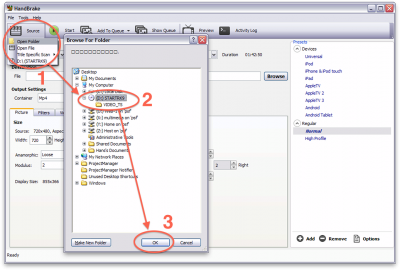
HandBrake – Select your DVD
After clicking “OK” (3), HandBrake will start scanning the DVD.

HandBrake is scanning your DVD
Step 3: Select the Movie
Once the scan completed, HandBrake will pick what it thinks is the main movie. You can of course override this and select the specific part of the DVD you’re like to rip. Typically, the title with the longest playback time is your main movie, but that is not a guarantee!
Too many titles to choose from?
If you find yourself in the situation where it becomes difficult to decide what title to pick, for example when certain copy protection mechanisms tamper with the table of content, and it appears that you DVD has a truck load of movies on it (the so called “99 title problem”): read this article on how to detect which movie to rip or copy.
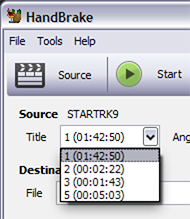
HandBrake – Select the movie to rip
Step 4: DVD Conversion settings – Video
First we can set the destination of the result file. Typically HandBrake will take a default location, like your desktop, and name the file based on what it found on the DVD (which can be a random guess). You can change the location and filename as you see fit. Keep in mind that the resulting file size for a normal movie is in the 1 -2 Gb size – make sure the destination drive has enough space available!
When ripping a DVD we basically convert (transcode) the DVD movie to a different file format and for this we will need to do a few settings. For your first DVD, you’d want to try the default settings as they are already pretty good, but you can fine tune the settings if you’d like. In this article you’ll find more details on how to fine-tune/tweak the settings.
First, since we want to create an MP4 or MKV: Select the desired “Format“. For most purposes choose “MP4“.
One of the nice things of HandBrake is the ability to work with presets, you will see them on the right.
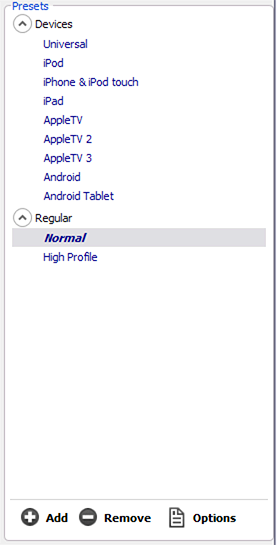
HandBrake – Presets for particular target devices
If you have a particular target device in mind, try to pick the one that closest matches one of the presets.
If you’re unsure or you have multiple devices in mind, then pick “Universal” – a preset I usually start out with.
Note : All settings after this point are optional! So you could jump right away to step 7 and click the “Start” button, but it might not be a bad idea to keep reading anyway …
Basic setting I use (that I’d start out with – which are slightly different than “Universal” – more optional fine tuning in this article):
Starters HandBrake Settings
| Field |
Setting |
| Video Codec |
H.264 (x264) |
| Framerate |
Same as source / Variable Framerate |
| Constant Quality |
RF: 20 |
| x264 Preset |
Placebo (slow but very good) or veryfast (fast and reasonable quality) |
| x264 Tune |
film (for regular movies) or animation (for classic animations or Manga) |
| H.264 profile |
3.0 or auto |
If you have multiple target devices in mind, check the option “iPod 5G Support” as well.
With these settings most DVD movies end up in the 1.2 – 1.5 Gb file size range. You can tweak this down if you’d like but then you’d have to play with an average bitrate instead of constant quality.
Note :
For Android devices, I’ve found that setting the “Video Codec” to “MPEG-4 (ffmpeg)” results in the most compatible format.
Note :
After tweaking and modifying all kinds of settings, in the now following paragraphs, you can save them as a new preset using the “+ Add” button at the bottom.
Step 5: DVD Conversion settings – Audio
Next click the “Audio” tab, where we can play with the audio settings.
Under normal circumstances I would choose the highest audio quality “Track” the DVD has to offer, which is typically (if available) AC3 Dolby Surround, in the language of your preference.
You now have 2 options to choose from:
1) Add only one Audio Track
In that case you will have to decide if you want the original sound track, unmodified (codec: auto passthru), or if you’d like, use a format like AAC (I prefer AAC coreAudio for Macs) or MP3 – as the cheaper playback devices are not always capable of AC3 playback!
2) Add multiple Audio Tracks
You can also choose, and this is what I do, to add the sound track in 2 (or more) formats. For example the fancy AC3, for the good video playback devices, and AAC (CoreAduio for MacOS X) or MP3 for the less capable playback devices. At the same token, you can also choose to add multiple languages as well (if available on the DVD).
Repeat these steps as often as you need to (click “Add Track” to add an audio track):
High Quality Audio Track
I always choose the first audio track using the codec “Auto Pasthru” (unmodified), which means that you will get the best audio quality when watching the movie … this is often the “AC3 Dolby Surround” audio track, if provided by the DVD.
Lower Quality Audio Track
I also always add a secondary audio track where I set the audio codec to a simpler format like MP3 or AAC. I would always choose one of the AAC variants, with a “Dolby Surround” or “Stereo” “mixdown” at a “Bitrate” of “160“.
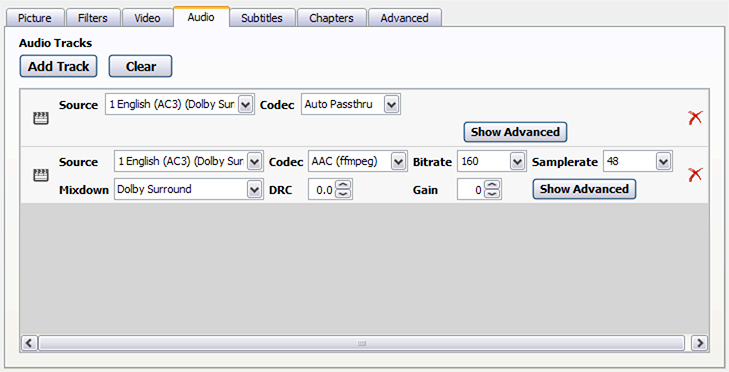
HandBrake example Audio settings
Step 6: DVD Conversion settings – Subtitles (optional)
Now that we have covered Audio and Video: Subtitles.
Of course subtitles is fully optional and you can leave them out if you’d like.
I usually add at least one subtitle: English Closed Caption. You can however enable as many as you’d like.
You will have to pay attention here though!
Some subtitles HandBrake wants to have “Burned In” – which is a bad idea all together.
It means that subtitles will always be visible and cannot be turned off!
So we really want to make sure that “Burned In” is NOT CHECKED!
More details about subtitles variations can be found on the HandBrake Wiki page.
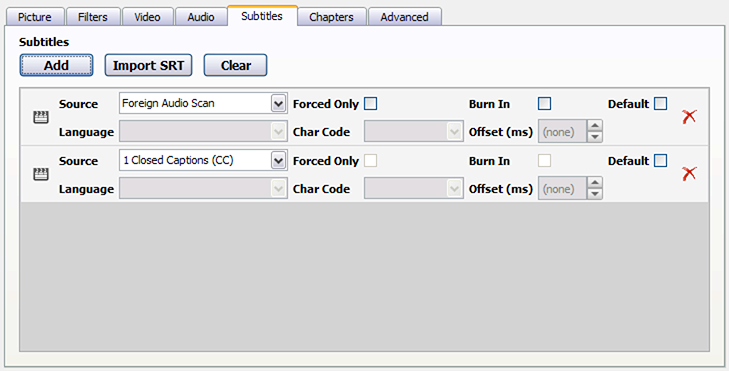
HandBrake Subtitles example
Step 7: Start Ripping!
This would be the time to click the “Start” button to start the ripping/copying/converting process.
Ripping will take a little bit and it mostly depends on the speed of your computer and the encoder settings you used.
Additional Tips
Advanced Tweaking of the Encoder
I wrote an additional article for those interested in additional optimzing and tweaking of the HandBrake encoder settings for h264.
I can highly recommend, even for beginners, to read thought this article. It’s not just about “better” settings but also about some of the basic principles of encoding video.
Using a Queue for sequential ripping of multiple DVD’s or video conversions
You do have the option – if you have multiple DVD Rom players connected to your computer, or want to convert multiple video files – to add everything you just did to the Queue (click “Add to queue”) and start the entire process you just went through again to then add that one to the queue as well. You can however NOT remove the DVD form the drive it’s in right now!
Once you filled the Queue, click “Start” and HandBrake will process the entire Queue in sequence.
Put the computer to sleep when done
One of the features I really appreciate is that you can have HandBrake put the computer to bed when done converting. Specially with conversion job that take a while, this proves very handy. If you’d like to enable this option, because you’re going to walk away from the computer and let HandBrake do it’s thing:
Click the menu (top of your screen) “Tools” “Options” “General” “When Done” and choose “Suspend“. You can even do this while HandBrake is in the middle of converting your DVD!
You can of course also choose for one of the other options …
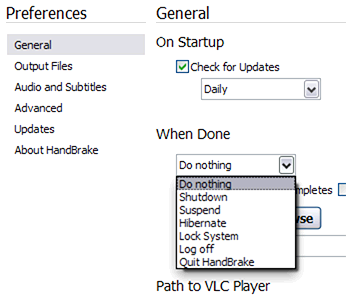
Handbrake – Go to sleep when done!
HandBrake not Ripping the entire movie
It can happen, for example due to particular copy protection, or a damaged disc, that HandBrake will not rip the movie correctly. I’ve found that MakeMKV, although often used for BluRay discs, does a great job recovering from those situations for DVD as well.
It is slower than HandBrake though.
Read: MakeMKV – Copy a Blu-Ray movie to MP4 or MKV.

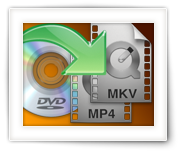







Comments
There are 2 comments. You can read them below.
You can post your own comments by using the form below, or reply to existing comments by using the "Reply" button.
I use Handbrake for transcoding video’s for web streaming. I really appreciated your explanation of some of the additional features and capabilities of Handbrake and your clear style of presentation. It makes it much easier to learn about what this product is capable of doing.
One feature I can’t seem to find any information on is the “Options”, “When Done”, “Send file to:” option. I would like to use this in conjunction with a program like WinSCP to transfer the completed file to my web site, but I haven’t been able to determine how to pass the file name in the “Arguments” field.
If you are aware of ways to use this option, could you provide some documentation on this. It seems like a really useful feature.
Brian S. Wilson
Hi Brian,
Thank you for the compliment!
I had never even payed attention to the “Send file to” option. We learn something new every day haha .
.
The only thing I could find about that is what I found in the Handbrake FAQ, under “General”, where it says that you can send the filename to an application (Mac only – so I’m not sure if this is an option under Windows). I would assume that it would execute the application something like this: <application> <filename video>
So as the first parameter. You’d probably have to write a script that catches the name or have an application that knows what to do with it. Since you use WinSCP, I assume you want to use SSH to upload it to (for example) your webserver.
Having played with SSH (on Mac), I can tell you that it might not be very easy to fully automate that.
Maybe using FTP is a better option?
hans